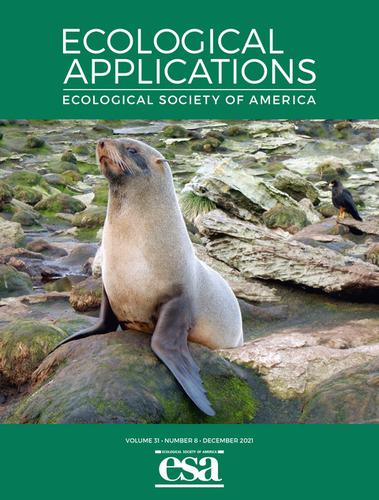当前位置:
X-MOL 学术
›
Ecol. Appl.
›
论文详情
Our official English website, www.x-mol.net, welcomes your
feedback! (Note: you will need to create a separate account there.)
Cover Image
Ecological Applications ( IF 4.3 ) Pub Date : 2021-12-01 , DOI: 10.1002/eap.2175
Ecological Applications ( IF 4.3 ) Pub Date : 2021-12-01 , DOI: 10.1002/eap.2175

|
COVER PHOTO: The movement and distribution of marine predators can help identify areas for conservation action and support the designation of Marine Protected Areas. Baylis et al. (this issue; Article e2426; doi:10.1002/eap.2426) used a range of methods to identify important marine areas for globally significant breeding populations of seals and seabirds on the Patagonian Shelf (including South American fur seals, Arctocephalus australis, pictured here) and quantified spatial overlap with proposed Falkland Islands Marine Managed Areas (MMAs). The authors show that while there is much to celebrate about the proposed MMAs, management at spatial scales matching marine predator movements requires a range of approaches. In addition, although the threshold-based criteria of International Union for Conservation of Nature (IUCN) Key Biodiversity Areas are standardized and globally applicable, methods to identify areas to be assessed against criteria are not standardized for tracking data, and key assumptions require further testing. Photo credit: Alastair Baylis.

中文翻译:

封面图片
封面照片:海洋捕食者的移动和分布有助于确定保护行动区域并支持指定海洋保护区。贝利斯等人。(本期;第 e2426 条;doi:10.1002/eap.2426)使用了一系列方法来确定巴塔哥尼亚大陆架上具有全球重要意义的海豹和海鸟繁殖种群的重要海洋区域(包括南美海狗、北极海豹),如图)以及与拟议的福克兰群岛海洋管理区 (MMA) 的量化空间重叠。作者表明,虽然提议的 MMA 有很多值得庆祝的地方,但在与海洋捕食者运动相匹配的空间尺度上进行管理需要一系列方法。此外,虽然国际自然保护联盟(IUCN)关键生物多样性区域基于阈值的标准是标准化的并在全球范围内适用,但根据标准确定要评估的区域的方法并未标准化以跟踪数据,关键假设需要进一步测试. 照片来源:阿拉斯泰尔贝利斯。

更新日期:2021-12-01

中文翻译:

封面图片
封面照片:海洋捕食者的移动和分布有助于确定保护行动区域并支持指定海洋保护区。贝利斯等人。(本期;第 e2426 条;doi:10.1002/eap.2426)使用了一系列方法来确定巴塔哥尼亚大陆架上具有全球重要意义的海豹和海鸟繁殖种群的重要海洋区域(包括南美海狗、北极海豹),如图)以及与拟议的福克兰群岛海洋管理区 (MMA) 的量化空间重叠。作者表明,虽然提议的 MMA 有很多值得庆祝的地方,但在与海洋捕食者运动相匹配的空间尺度上进行管理需要一系列方法。此外,虽然国际自然保护联盟(IUCN)关键生物多样性区域基于阈值的标准是标准化的并在全球范围内适用,但根据标准确定要评估的区域的方法并未标准化以跟踪数据,关键假设需要进一步测试. 照片来源:阿拉斯泰尔贝利斯。












































 京公网安备 11010802027423号
京公网安备 11010802027423号